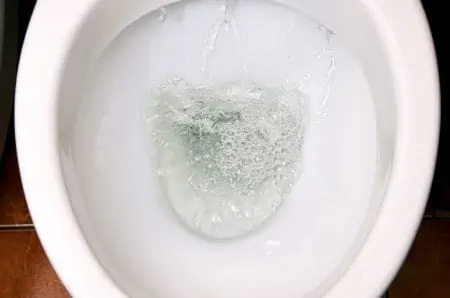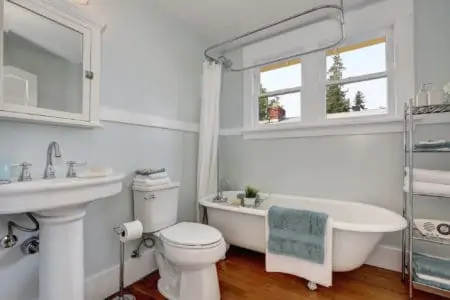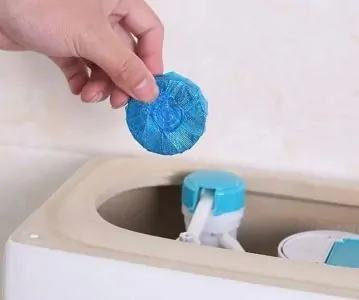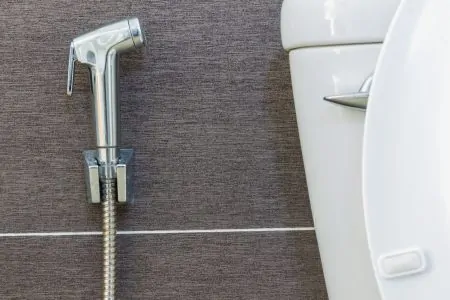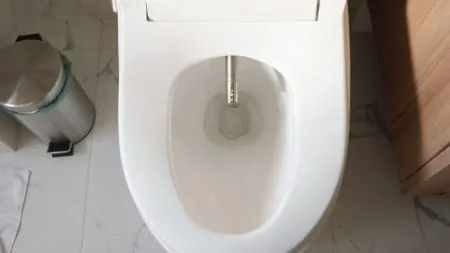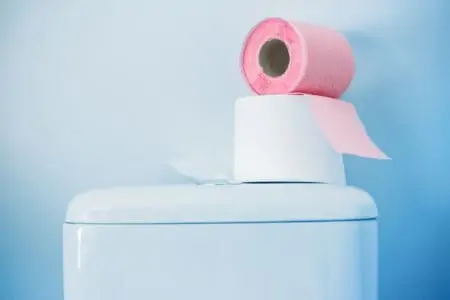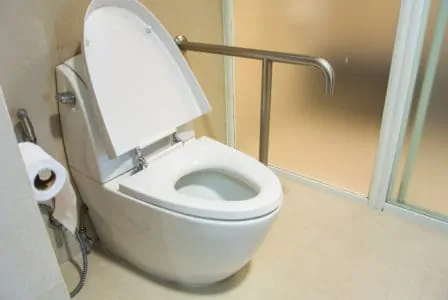“Why does my toilet keep running?” is a valid question, especially as the problem will likely get worse. A toilet constantly running will waste water, increase your bills, and flush inefficiently, leading to blockages.
Knowing how to stop a toilet from running will save you a packet in plumber’s costs and stand you in good stead for future repairs.
Key Takeaways
- Common causes of a running toilet include a faulty flapper, incorrect water level, or a stuck handle.
- Fixing a running toilet often involves adjusting or replacing parts like the flapper, fill valve, or flush valve.
- A constantly running toilet can increase your water bill and waste a valuable resource, so addressing the issue is important.
- Understanding how a toilet works will help you diagnose and fix problems, potentially saving you money on plumber’s fees.
How Does a Toilet Work?
If you are repairing a running toilet yourself, you need to know how a toilet works. Using this diagram as a reference, we break down the components of a toilet to explain what they do.
Float Ball
The float ball regulates the refill tube, telling it when to trigger. The float moves up and down with the water levels in the tank.
Overflow Tube
The overflow tube is a safety mechanism that prevents the tank from flooding. When water levels rise too high, the overflow channels the excess water away from the tank.
Fill Valve
The fill valve is responsible for refilling the tank after operating the flush lever. It is connected to the float valve and triggers when the water levels are low enough.
Flush Lever
The flush lever sits on the outside of the toilet tank. When you’ve done your business, you activate the lever, and the toilet flushes.
Take Note
Not all toilets have levers. Some have a push-button flush that sits on top of the tank.
Flapper
The flapper is a rubber flange sitting between the tank’s water inlet and the bowl. Water flows into the bowl via the inlet holes when the flapper lifts. The flapper falls back down and seals the water inlet as the tank empties.
Lift Chain
The lift chain connects the flapper to the fill valve and the flush lever. When you pull the lever, it lifts the chain, which raises the flapper.
Inlet Holes
The inlet holes are located just under the rim at the rear of the toilet bowl. Water flows from the tank and enters the bowl here. They are designed to evenly spread the water to wash the entire bowl during the flush.
Trap
The trap is located at the rear of the toilet bowl and traps water to stop sewer gasses from seeping back into your home.
Why Does My Toilet Keep Running?
A continuously running toilet is not only annoying, but it is wasteful. Gallons of water flowing down the drain is costly and bad for the planet. But what are the causes of your toilet running all night? Let’s find out.
Too Much Water In the Tank
Your toilet cistern water level is finely balanced. The system doesn’t work if you have too much water in the tank.
The Problem
If the water level sits above the overflow tube, water will drain down the overflow, causing the toilet to run continuously.
How to Fix It
Resolving this issue is simple enough. Adjust the float level by adjusting the clip that holds the rod attached to the float and lever handle. This ensures that the tank refills with the correct amount of water.
Some older toilets have ballcock valves that raise and lower on a pivoting arm. You can adjust the arm by turning a screw, allowing the tank to fill to the correct level.
Faulty Flapper
The flapper is a rubber stopper that sits over the water inlet between the tank and the bowl. It attaches to a lift chain connected to the flush handle.
The Problem
Flappers perish over time because they get coated in mineral deposits and turn brittle. If the rubber splits or cracks, water enters the toilet bowl, causing your toilet to run constantly.
How to Fix It
When the flapper fails, there is only one solution: replace it. You can buy flappers online or at the local hardware store cheaply enough. This Korky model fits most toilets and is affordable.
Unclip the old flapper from the lift chain and attach the new one. It’s that simple!
Top Tip
To check that the flapper is the culprit, push down on the center of the flapper for a few seconds with water in the tank. If the added pressure stops the water from flowing, your flapper has failed to seal the inlet.
Flapper Chain Is Too Short
The size of your flapper chain determines how well the flapper operates. Because the chain is integral to the flushing operation, ensuring it is the correct length is crucial.
The Problem
When the lift chain is too short, the flapper lifts but doesn’t close. This leaves the inlet pipe open, feeding water from the tank to the bowl.
How to Fix It
Given that chains are so inexpensive, it makes sense to replace them. You clip one end to the lift arm and the other to the top of the flapper.
Make sure that the chain is taught but not overtightened. Test the flush handle to see if the flapper operates as it should, and the problem is solved.
Refill Tube Needs Adjusting
If the refill tube is incorrectly set or poorly installed, it affects the amount of toilet water you have available for flushing.
The Problem
If the float attached to the fill tube is set incorrectly, when water floods into the toilet tank, it fails to switch off when the water reaches the correct level. This causes the water to drain down the overflow tube, creating a running toilet.
Another cause could be an incorrectly installed tube, and the float is restricted when it rises or falls.
How to Fix It
Adjusting the float is easy. Simply unclip the rod and move the float up or down as required and reclip it back into place. Some floats are small cups that wrap around the refill tube, while others have a screw that you adjust using a screwdriver.
Adjusting the float a quarter-turn counterclockwise lowers the water levels. Keep adjusting it using trial and error until the water stops flowing down the overflow tube.
Faulty Fill Valve
The fill valve regulates water flow from the supply line. It fills the tank until the float reaches the required level. Then it shuts off the water supply, leaving the tank full for the next flush. Without it, the tank would fail to refill after you flush.
The Problem
If you remove the tank’s lid and see water flowing into the overflow tube, the fill valve is likely faulty. You may also experience the valve turning off and on randomly every few minutes.
How to Fix It
The best remedy is to replace the fill valve. Some new-style toilets operate without a ball float, meaning that all the integral parts are encased inside a sealed plastic unit.
You will need to drain the water from the system by isolating the water supply valve. Turn it to the off position and flush the toilet. Wait while the tank drains before unscrewing the fill valve.
Water tank fill valves are easy to buy and readily available online and in hardware stores. You will need an adjustable wrench to remove the water supply pipe and the locking nut at the base of the valve. Once free, you can lift the valve out and swap it with the new model.
This Fluidmaster valve is universal and costs less than $15, making it a great choice. Now it’s time to tighten the locking nut and turn the water back on.
Faulty Flush Valve
The flush valve controls water every time you operate the flush lever. It allows water to drain from the tank and triggers the fill valve to refill the tank when it empties.
The Problem
When you pull the flush handle, the toilet fails to flush. Worse than that, you can hear running water in the toilet bowl.
How to Fix It
The simplest way to fix the flush valve issue is to replace it. Isolate the water supply at the wall and drain the tank using the flush handle. Disconnect the flush valve at the base by removing the locking nut with an adjustable wrench.
Remove the old valve and swap it for the new one. Reattach the locking nut, turn the water back on, and let the water tank fill.
Stuck Toilet Handle
The flush handle is integral to a working toilet. You can’t flush without it, and waste matter sits in the bowl.
The Problem
When your flush lever gets stuck, it leaves your toilet in a state of permanent flushing. The tank never refills, and the toilet continuously runs.
How to Fix It
To remove the toilet handle, lift the tank’s lid and locate the locking nut on the other side of the handle. Some are tightened by hand, but others require an adjustable wrench. Remove the nut, disconnect the lift chain from the arm, and remove the broken part.
Follow the instructions in reverse to fit the new style handle. They are cheap enough to buy (this DANCO handle is an affordable option) and readily available online or from hardware stores.
Is It Bad If My Toilet Keeps Running?
It won’t harm you or result in a dangerous situation, but it will cost you financially. Every drop of water is a nickel or dime flushed down the drain. It’s also terrible for the environment because it wastes a precious resource.
Not only is a running toilet annoying, but if left unchecked, it could lead to more expensive problems. And remember that a running toilet is not going to correct itself.
FAQs
Why Is My Toilet Running?
Now you know why your toilet keeps running after you flush and how to fix it. All the working parts of your toilet are located in the toilet tank. Draining the tank is easy, as is getting access to the components.
If this article saves you money on plumber’s costs and gives you the confidence to have a go yourself, we have made the world a better place. Our mission is complete, and you can look forward to a fault-free toilet for years to come.
